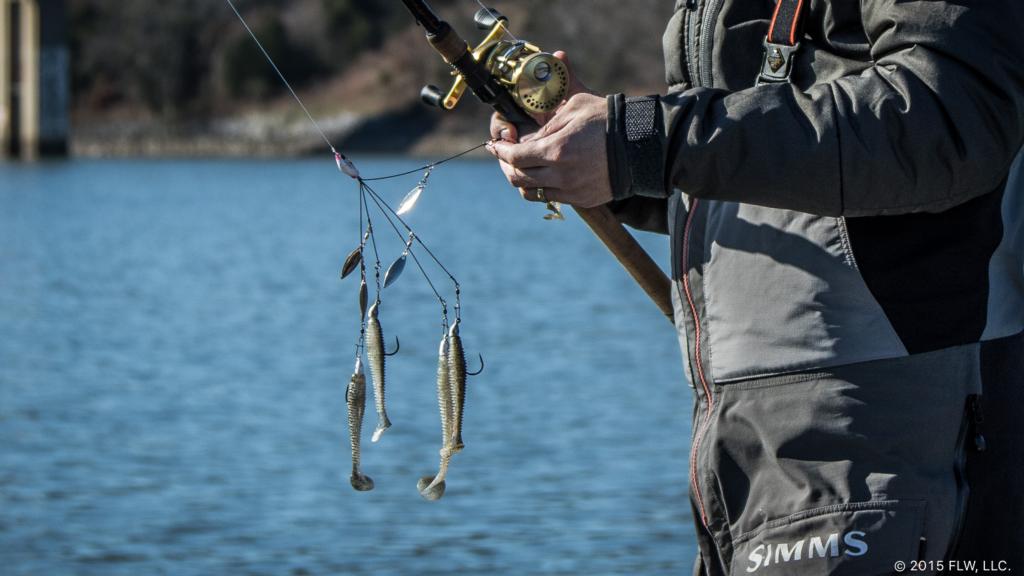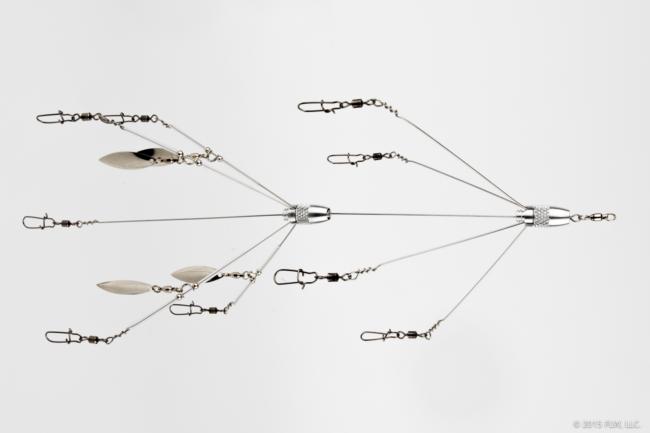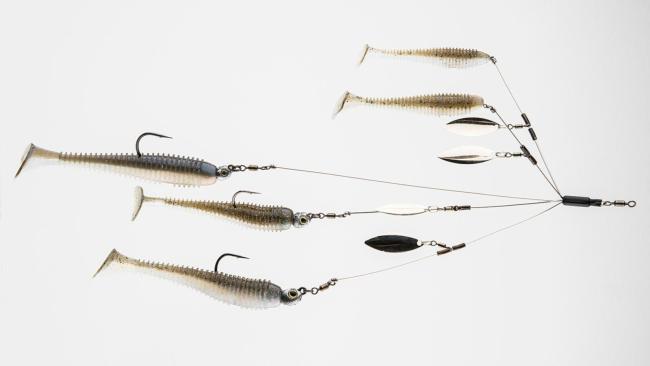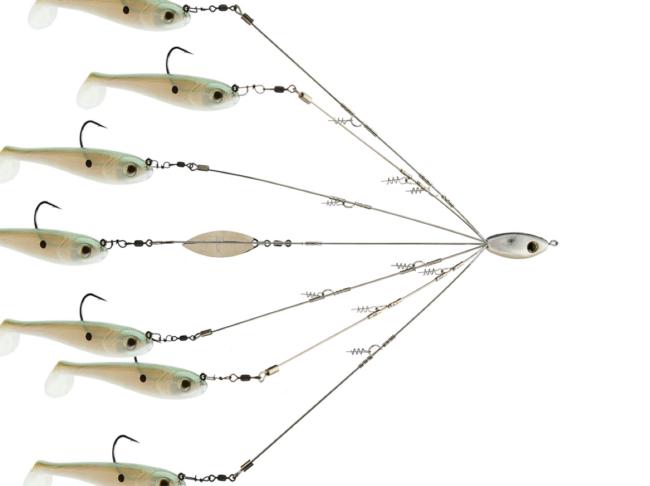4 Umbrella Rig Applications
Now that umbrella rigs are a staple, this is how to make them work

There’s been a considerable amount of innovation since umbrella rigs first broke out at the Walmart FLW Tour event on Lake Guntersville in 2011. Though the principle of imitating a school of baitfish remains the same, the anglers who have put in the time to learn and refine the new rig have certainly reaped the rewards.
No longer a magic bait, and now illegal on the FLW Tour and restricted at the FLW Series and BFL levels, the rig can still put fish in the boat for anglers willing to throw it, especially in the winter months.
We caught up with a few anglers willing to reveal how they make it happen with the rig these days.
1. LeHew Goes the Whole Nine Baits
Shane LeHew is one of the more notable umbrella rig innovators on Tour. The young North Carolinian cut his teeth with the rig on Lake Norman, and he and his dad started Shane’s Baits to cater to those who admired their advanced umbrella rig setups.
LeHew’s favorite rig to throw is the Blades of Glory with the blades on the lower portion. The rig is essentially two umbrella rigs stuck together, reminiscent of the humorous Photoshopped renditions that made the rounds on Facebook back in the day. His go-to configuration is 2.8-inch Keitech Swing Impact FAT swimbaits (shad-colored in clear water and white in muddy water) all around on 1/16-ounce Shane’s Baits jigheads.
For tackle to match the beefy rigs, LeHew prefers the Fitzgerald Rods 7-foot, 6-inch heavy Okeechobee Rod, which is a heavy rod with a moderate tip, and a 6:1 gear ratio baitcasting reel paired with 20-pound-test Gamma Edge fluorocarbon.
While some like to throw big braid with umbrella rigs, LeHew prefers flouro for a number of reasons.
“I know it sounds wrong, because braid floats, but I think the fluorocarbon allows it to sink a little bit slower because of the big diameter,” he explains. “If you’re throwing it in the winter the fish are pretty lethargic, and you want to go slow.”
As far as actually fishing the rig on Norman and other Carolina lakes, LeHew has some pointers to keep in mind.
“Typically the retrieve I start out with is super slow. But, if you’re fishing it around docks or cover you don’t need to fish it as slow,” he says. “With our rig, I know it falls about 1 foot per second, so I can count it down and fish it really close to the bottom in the winter when the fish are sitting below bait.
“I run as many hooks as I can [and still be legal]. A lot of times the fish will crash through that rig without their mouths open, and you need more chances to hook them. A lot of times, if I’m fishing around brush, I’ll rig the front ones with a weedless jighead. Then you can feel them tick into the cover and pull it up so the bottom swimbait doesn’t get hung.”
When hung up, LeHew says a typical crankbait plug knocker usually is all it takes to get the rather expensive rig back.
2. Blaylock Hunts Big Ones
Though he initially was an umbrella rig detractor and still supports keeping them out of tournaments, Arkansas pro Stetson Blaylock has been known to chunk an umbrella rig and is now quite skilled with it.
“My next-door neighbor builds them for me,” says Blaylock. “I like either a five- or seven-wire rig with an unweighted head.
“I want the bait to fall hooks first so the head doesn’t settle down into structure and so that when you hop it up or start working the bait it looks like it’s moving up, not forward,” he adds. “I also never throw one without blades, but I think it matters to have blades a lot more on sunny days than cloudy days.”
Blaylock has no stated preference in jigheads, but he usually opts for 1/8-ounce heads around the perimeter with a 3/8-ounce head in the middle, depending on the swimbaits he’s throwing or how windy it is. Usually, 3- to 5-inch swimbaits get the call for the outside with a 5-inch bait up the middle.
“When I throw a rig I’m not fishing for numbers; I’m fishing for big ones,” explains Blaylock. “Anytime I throw it I throw it on braid with a real stiff rod with a soft tip. I’m usually fishing for big ones around cover. There’s no reason to have any give in the setup. You want to just reel them in and lift them into the boat.”
Blaylock’ setup consists of a 13 Fishing Concept E casting reel with 6.6:1 gear ratio, 65-pound-test Seaguar Smackdown Braid and either a 7-6 or 7-11, heavy-power 13 Fishing Envy Black casting rod.
When he’s fishing a rig, Blaylock usually likes to keep it low and slow.
“There’s more to it than throwing it out there and reeling it in; the fish are getting accustomed to the rig. I’ve had 5-pounders just come up and bump it, and that never used to happen,” Blaylock says. “I like to get mine all the way to the bottom and fish it almost like a jig or anything else. I want it right next to the cover I want to fish. Some days a steady retrieve is best, but it all depends on what the fish are telling you.”
3. Borofka Takes a Left Coast Angle
Jason Borofka created a mini-craze of his own with a custom-designed umbrella rig back in 2014 in the FLW Series Western Division event at Lake Havasu. Now umbrella rigs have been embraced almost universally on the West Coast, and Borofka is at the head of the pack.
Out of necessity, Borofka and his friend and business partner Tom Nieto started building a finesse umbrella rig to their own specifications. Later, the two started G-Funk Baits to sell it.
The design of their rigs is based around having only two or three hooks with baits that are lighter and of higher quality. The G-Funk rigs are also designed specifically to fit a variety of Keitech Swing Impact FAT swimbaits. From Owner split rings to a proprietary head design, everything about the rigs is tuned to be tournament-ready.
As an example of the rig’s uniqueness, Borofka says that it lands more softly than other renditions of similar size and configuration. Instead of it plunking down with a splash into a shallow pocket, the G-Rig’s form and balance tend to make it land with a sound akin to light rain.
“My favorite G-Rig is the three-hook, five-wire model,” says Borofka. “I like to run three 1/8-ounce jigheads and two baits rigged just on springs.”
Borofka’s bait array is fairly simple: a pair of 2.8-inch Keitechs on the two top wires, a 4.3-inch Keitech on a jighead in the middle and two 3.8-inch Keitechs on jigheads on the lower wires.
“That whole configuration makes it come through the water perfectly just as soon as it hits the water,” he says. “A lot of times I’ll also make that middle bait just a little off-color –usually just a little more bold – compared to the other baits.”
For tackle, Borofka opts for a 6.2:1 Shimano Curado 300E, 20-pound-test Berkley Trilene Big Game mono and a 7 1/2- or 8-foot, medium-heavy-power swimbait rod.
“I’d say 80 percent of the time I use a steady retrieve, though there have been situations when I’m doing something different, like maybe when I speed it up slightly,” Borofka adds. “If I’m fishing it around cover it’s good to make a long cast past the cover and then speed up or make some other little change when it gets to the cover. That can really help if you’re fishing behind guys or getting followers but not getting bit.”
4. Martin Rolls with a Variety
Casey Martin was in the boat as a co-angler when Paul Elias busted out the umbrella rig on Guntersville four years ago. A few seasons later Martin used it to win at Chickamauga in his rookie year on Tour. Suffice it to say, Martin has a lot of affinity for the rig – and the skill to fish it effectively.
As both a pro and a guide on Guntersville, Martin employs a variety of umbrella rigs. His preference is the Picasso Bait Ball Extreme, a giant rig with seven wires that each holds a blade, and up to seven hooks and nine dummies. For tournament competition, he’s forced to scale back to the Picasso School-E-Rig Bait Ball Junior, which is a traditional bladed five-wire model. Finally, Martin likes to use the Picasso Flash Back Junior, a five-wire, eight-blade version, on guide trips when his clients want to throw the umbrella rig but aren’t up to chunking the Bait Ball Extreme.
“My rig setup is a 7-10, extra-heavy Duckett Micro Magic Pro, a reel with a 6:1 gear ratio and 25-pound-test fluorocarbon,” explains Martin. “I don’t like braid because of how it digs into the spool on the hookset. I usually use Z-Man Grass KickerZ in ‘smokey shad,’ but I’ll go to pearl in muddier water. I’ve noticed the rig doesn’t excel in dirty water.”
For Martin, the umbrella rig is a year-round tool.
“When I’m fishing deep on ledges in the summer I usually go with five 3/8-ounce Picasso Smart Mouth jigheads,” he says. “In the winter you’re usually fishing it higher in the water column, and I use 1/8-ounce heads then.
“I was fishing with heads that were too heavy when I first started out,” details the Guntersville pro. “Most of the time, you want to be fishing lighter heads to keep it in the same part of the water column as a suspending jerkbait.”
Martin also offered some advice for getting the elusive umbrella rig double.
“If you leave the rig out after you set the hook – just hold for a minute and don’t crank – more often than not you’ll catch more than one. It’s hard to risk in a tournament, and it doesn’t happen as much in the winter, but it happens a lot in the summer.”


